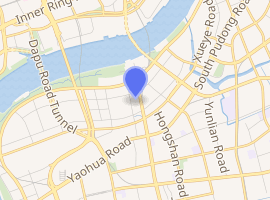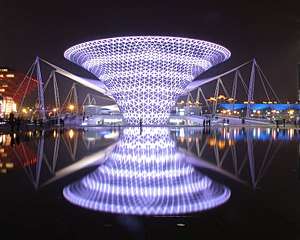Expo Axis
The Expo Axis is one of the world's largest membrane roofs. It spanned the entrance and boulevard building of the World Exposition 2010 in Shanghai.
 Nighttime view of the Expo Axis | |

| |
| General information | |
|---|---|
| Town or city | Shanghai |
| Country | People's Republic of China |
| Coordinates | 31.185733°N 121.487986°E |
| Construction started | 2006 |
| Completed | 2010 |
| Inaugurated | May 1, 2010 |
| Client | Shanghai World EXPO Land Holding Co. Ltd., Shanghai |
| Dimensions | |
| Other dimensions | Projection area Membrane roof: 65,000 m2 Span: 100 m Area freeform double-curved framework: 32,000 m2 Dimension boulevard: 100 × 1,000 m |
| Technical details | |
| Floor area | 334,000 m2 |
| Design and construction | |
| Architecture firm | SBA International Stuttgart / Shanghai Cooperation: ECADI, Shanghai |
| Structural engineer | Knippers Helbig KHIng Gmbh Stuttgart / New York City |
The combination of the membrane structure, which has a surface of 65,000 m2 in total with a span of 100 m, and the six steelglass funnels of 45 m height, formed of a freeform double-curved framework, constitutes the landmark of the Expo Shanghai 2010.[1]
Structure

Besides the China Pavilion, the Expo Axis is the largest and most significant building on the site. It forms the central entrance area and provides 334,000 m2 effective area for numerous facilities. Via the about 1 km long and about 100m wide axis, which stretches across the entire site to the Huangpu River, the visitors are guided to the various national and theme-based pavilions.
The Expo Axis and its boulevard is one of five buildings which remain after the end of the world expo to form the centre of a new urban district of Shanghai.
The Expo Axis is covered by a membrane roof with a total surface of 65,000 m2, currently the largest of its kind in the world. The roof is carried by 19 interior and 31 exterior masts and by six funnel shaped framework shells consisting of steel and glass. It has a height of 45 m and a free projection of 80 m. These so-called Sun Valleys direct natural LED light below.
The design and development of the structure originate from SBA International and Knippers Helbig Advanced Engineering Stuttgart / New York City. In terms of structure and shape, the roof structure lives up to Stuttgart’s tradition of the internationally respected lightweight constructions, including the tent construction of the German Pavilion and the Buckminster Fuller-designed geodesic dome American Pavilion at Expo 67 in Montreal.
Gallery
 Building site
Building site Column head
Column head Completed Construction of Expo Axis in December 2009
Completed Construction of Expo Axis in December 2009 Expo Axis, May 2010
Expo Axis, May 2010 Expo Axis, May 2010
Expo Axis, May 2010 Expo Axis, May 2010
Expo Axis, May 2010 Sun Valley Expo Axis, May 2010
Sun Valley Expo Axis, May 2010 Membrane Construction Expo Axis, May 2010
Membrane Construction Expo Axis, May 2010
References
- "Archived copy". Archived from the original on 2011-07-13. Retrieved 2010-03-29.CS1 maint: archived copy as title (link)
External links
| Wikimedia Commons has media related to Expo Axis. |